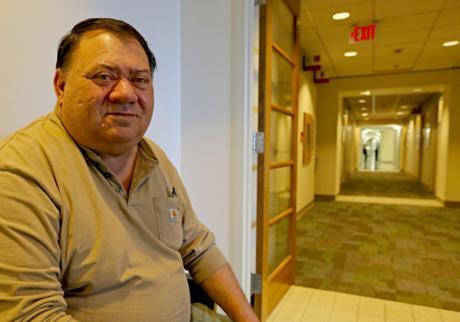
Donald Siefken is a 64-year-old Army veteran from Kennewick. Earlier this year he showed up at the Seattle VA Hospital, but couldn’t get its staff to help him inside and had to call 911. Seattle Times Photo
Seattle Times: When Donald Siefken drove up to the Seattle VA hospital emergency room earlier this year with a broken foot, all he asked for was a little help getting inside. Instead, a hospital employee who answered Siefken’s cellphone call told him to call 911 himself, then hung up on him, Siefken said.
Frustrated to tears, the 64-year-old retired truck driver and Army vet from Kennewick placed the emergency call while parked just feet away from the ER entrance. “They won’t come out and get me, do you believe that?” Siefken asked an emergency dispatcher, his voice wavering. “They told me to call 911 and hung up on me.”
In response to inquiries about Siefken’s case, a VA spokesman initially told The Seattle Times the hospital’s response was appropriate. “I know it sounds counterintuitive because someone is just 10 feet away, but it is our policy to do that,” said Chad Hutson, spokesman for the Veteran Affairs Puget Sound Health Care System. “Our policy is no different than Harborview or Swedish or other hospitals in Washington.”

But that’s not the case. And, after a reporter requested Siefken’s medical file and other records, the hospital changed its story, issuing a written statement earlier this month.
“After a complete review regarding this Veteran’s visit to the VA Puget Sound Seattle campus emergency room, we have determined we did not do the right thing to ensure the Veteran had assistance into the emergency room,” the statement said. It added that ER personnel “should have called the appropriate staff to come and assist the patient, ensuring he made it into the emergency room safely.” The hospital now plans “corrective actions to ensure this does not happen again to one of our Veterans,” the statement said.
On Tuesday, Dr. William Campbell, the hospital’s chief of staff, also met with Siefken to apologize. “He first called me on Friday, and he was all over himself apologizing,” Siefken said, before Tuesday’s meeting. Citing privacy concerns, the VA declined The Times’ request to observe Siefken’s meeting with Campbell.
“Just wouldn’t listen”
Siefken’s odyssey to a formal apology began on the afternoon of Feb. 27.
While getting ready to drive his wife from their Kennewick home to catch a red-eye flight at Seattle-Tacoma International Airport, Siefken “stepped down funny and heard a snap,” he said. During the long drive, his foot started to swell and hurt. “So I dropped my wife off at the airport, and headed right up to the VA.” By the time Siefken arrived, shortly after 3:30 a.m., his foot had swollen to the “size of a football” and was throbbing with pain, he said.
Siefken parked outside the ER on the ambulance roundabout and, because he couldn’t walk, called the front desk for help. The worker who answered “couldn’t for the life of him understand why someone from Kennewick was trying to get treated in Seattle,” Siefken said. “I tried and tried to explain it to him, but he just wouldn’t listen.” After an argument, Siefken said, the employee told him, “ ‘No, we’re not going to come get you. You’re going to have to call 911 and you’ll have to pay for that.’ ”
Siefken dialed 911 at about 3:40 a.m., records show. “They won’t come out and get me in a wheelchair,” he told a dispatcher. “How far away from the building are you?” she asked. “Well, I’m right by the ambulance entrance,” he said.
By 3:47 a.m., a Seattle fire captain and three firefighters manning Engine Company 30 arrived to wheel Siefken into the ER. Staff members examined him, took X-rays, put a boot on his foot and prescribed Hydrocodone for his pain.
Siefken, who declined to take the medication for fear he’d be unsafe to drive, drove back home to Kennewick after the hospital wouldn’t put him up for the night. He arrived four hours later, took a painkiller and crawled into bed.
When The Times asked about the case, Hutson initially said the hospital’s policy — like all other VA and private hospitals — was to call 911 to summon emergency medical responders to handle such a situation. “It has to do with liability and to make sure, like in this case, that the right personnel are there to safely extract the person from the vehicle,” Hutson said. (Hospital personnel aren’t the “right personnel” to safely move a patient?)
He added that the VA employee who talked to Siefken had asked, “ ‘Can you call 911?’ And he said, ‘yes.’ This was not an emergency situation, so we didn’t need to make the call for him.”
But that’s not how it happened, Siefken said. “My pain level was a 10 on a scale of 10,” he said, “and they just hung up on me.”
At least one other hospital and the Washington State Hospital Association noted hospital policies for such situations can vary.
“If we have a person that comes up our ambulance ramp in their personal vehicle and can’t make it in, we will transfer them into the emergency department,” said Susan Gregg, spokeswoman for Harborview Medical Center.
Against federal law
A federal law called the Emergency Medical Treatment and Labor Act (EMTALA) generally requires most hospitals to conduct a medical screening of anyone who shows up seeking emergency treatment. The law’s so-called “250-yard rule” clarifies that hospitals have an “affirmative obligation” to treat patients — whether they make it inside an ER or not — when they arrive on a hospital campus.
“If you are close to the emergency department, they should basically come up and wheel you into the hospital,” said Barbara Tomar, federal affairs director for the Washington, D.C.-based American College of Emergency Physicians.
EMTALA applies primarily to hospitals that accept Medicare and Medicaid patients. The law doesn’t technically apply to VA hospitals, but the VA voluntarily complies with its policies to provide emergency care “to individual patients presenting to the Emergency Department,” the agency’s Emergency Medicine Handbook shows.
Yet, even in its written statement conceding it mishandled the case, Seattle’s VA hospital noted it does not consider Siefken’s situation an emergency. “Policies used to make the recommendation to call 911 for assistance, at the time of the emergency room visit, did not apply to this particular situation due to the nonemergent needs of the Veteran,” the statement said.
Tomar, whose organization represents 33,000 trained emergency doctors, said a broken foot can pose complications and is widely considered an injury that warrants emergency care subject to the federal law.
On Tuesday, while waiting to meet the hospital’s chief of staff, Siefken said his foot has not fully healed. “They said they’re sorry and they’re going to change things so this doesn’t happen again,” Siefken added. “That’s all I really wanted.”
See also:
- VA claims living veteran is dead, sends burial check, cuts benefits
- Veterans’ bodies left to rot in L.A. morgue
- 179% increase in backlog of veterans disability claims under Obama
- Empty promise: Michelle Obama’s campaign to end veteran homelessness
- FBI launches criminal investigation into VA scandal; Senate passes bill to fix problem
- Phoenix VA hospital changed records to make patients who’d died waiting for treatment appear alive
- Veterans die while waiting for MONTHS to see a doctor at VA hospitals
- Vet Finally Gets VA Doctor’s Appointment – 2 Years After He Died
- Veterans facing long wait times to schedule doctor appointments
DCG

